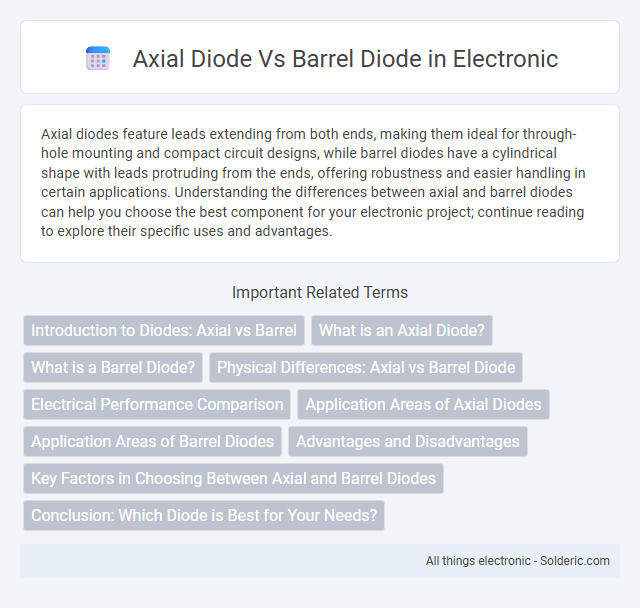Axial diodes feature leads extending from both ends, making them ideal for through-hole mounting and compact circuit designs, while barrel diodes have a cylindrical shape with leads protruding from the ends, offering robustness and easier handling in certain applications. Understanding the differences between axial and barrel diodes can help you choose the best component for your electronic project; continue reading to explore their specific uses and advantages.
Comparison Table
| Feature | Axial Diode | Barrel Diode |
|---|---|---|
| Physical Shape | Cylindrical with axial leads | Cylindrical, similar to barrel shape |
| Lead Configuration | Two leads extending from opposite ends | Designed for easy PCB insertion, leads on barrel ends |
| Common Applications | General-purpose rectification, switching | High voltage, pulse circuits, RF applications |
| Packaging | Encased in glass or plastic with colored bands | Typically glass-encapsulated with axial leads |
| Current Rating | Low to medium current (varies by model) | Often supports higher surge currents |
| Common Types | 1N4148, 1N4001 series | 1N60, 1N34A (germanium diodes) |
Introduction to Diodes: Axial vs Barrel
Axial diodes and barrel diodes differ primarily in their packaging and applications, with axial diodes featuring leads on both ends for through-hole mounting, while barrel diodes have a cylindrical shape optimized for compact surface mounting. Axial diodes provide better heat dissipation and are commonly used in power rectification, whereas barrel diodes excel in space-constrained circuit designs due to their smaller footprint. Understanding these differences helps you select the appropriate diode type for efficient circuit performance and reliability.
What is an Axial Diode?
An axial diode is a type of semiconductor diode characterized by its cylindrical shape with leads extending axially from both ends, allowing for straightforward integration into circuit boards. It is primarily used for rectification, switching, and signal modulation due to its fast recovery time and low forward voltage drop. Compared to barrel diodes, axial diodes offer easier alignment in automated manufacturing and are favored in applications requiring compact, linear layouts.
What is a Barrel Diode?
A Barrel diode is a type of semiconductor diode characterized by its cylindrical, barrel-shaped encapsulation, which allows for efficient heat dissipation and compact design in electronic circuits. Unlike the axial diode with leads extending from both ends, the barrel diode's unique form factor supports high-frequency and power applications due to reduced parasitic inductance. Your choice of diode depends on the application's spatial constraints and electrical performance requirements, with barrel diodes offering advantages in size and thermal management.
Physical Differences: Axial vs Barrel Diode
Axial diodes feature a cylindrical body with leads extending from both ends along the same axis, enabling easy insertion into through-hole PCB layouts and allowing efficient heat dissipation. Barrel diodes, often found in older or specialized electronics, have a shorter, more compact shape resembling a small barrel or capsule, with leads protruding from each end but positioned to minimize the diode's overall length. These physical differences impact mounting techniques, space utilization on circuit boards, and thermal management capabilities in electronic designs.
Electrical Performance Comparison
Axial diodes typically exhibit lower forward voltage drops and faster switching speeds compared to barrel diodes, making them suitable for high-frequency applications. Barrel diodes offer robust thermal performance and higher current handling capacity due to their larger surface area and packaging design. The choice between axial and barrel diode greatly impacts circuit efficiency, with axial diodes favored in compact, high-speed circuits, while barrel diodes excel in power regulation and rectification tasks.
Application Areas of Axial Diodes
Axial diodes are extensively used in power rectification applications within consumer electronics, automotive systems, and industrial equipment due to their ability to handle high current and voltage. Their compact and elongated form factor suits circuit boards requiring efficient space utilization and reliable surge protection. Common use cases include DC power supply units, voltage regulation circuits, and reverse polarity protection in automotive wiring harnesses.
Application Areas of Barrel Diodes
Barrel diodes are primarily used in high-frequency mixing and detection applications due to their low capacitance and fast switching capabilities. They excel in microwave and RF circuits, where their performance in signal demodulation and frequency conversion is critical. You will often find barrel diodes implemented in communication equipment, radar systems, and signal processing modules.
Advantages and Disadvantages
Axial diodes offer a streamlined design with easy PCB mounting and efficient current handling, making them ideal for space-constrained applications, though their axial leads can limit high-frequency performance. Barrel diodes provide better heat dissipation and robustness due to their cylindrical shape, yet they tend to be bulkier and harder to install in compact circuits. Your choice depends on balancing space constraints with thermal and frequency requirements for optimal diode performance.
Key Factors in Choosing Between Axial and Barrel Diodes
Key factors in choosing between axial and barrel diodes include form factor, installation method, and current handling capabilities. Axial diodes feature leads extending from both ends, making them ideal for through-hole mounting and compact PCB layouts, while barrel diodes typically have a cylindrical shape suited for high-current applications and robust mechanical stability. Your choice depends on the space constraints, electrical requirements, and ease of assembly needed for your specific electronic design.
Conclusion: Which Diode is Best for Your Needs?
Choosing between an axial diode and a barrel diode depends on your specific application requirements, such as space constraints, current rating, and mounting preferences. Axial diodes offer compactness and easy through-hole installation suitable for limited PCB space, while barrel diodes provide robustness and higher power handling capabilities typically found in high-current circuits. Your decision should prioritize the diode's electrical specifications and physical form factor to ensure optimal performance and integration into your design.
Axial diode vs Barrel diode Infographic

 solderic.com
solderic.com